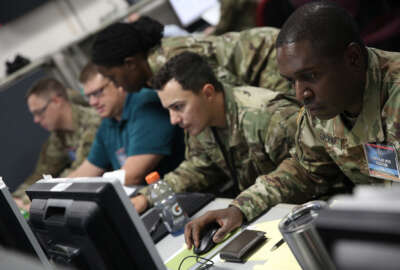With cloud migration, Army learned valuable lessons on standardization, sizing, culture
Gregg Judge of Army's ECMA said consistent language in cloud-based contracts, and around DevOps, allows the Army to pivot toward more standardized practices.
When the Army started consolidating data centers in 2015-2016, based on goals from Office of Management and Budget, migrating to the cloud was a way to do that. Nevertheless, top Army leadership did not always understand.
“[Chief of Staff of the Army] Gen. [James] McConville would always say ‘How do we convert the Army or transform the Army from the industrial to the digital age?’ Easier said than done in an organization that’s 250-plus years old,” said Gregg Judge, deputy director for the Army’s Enterprise Cloud Management Agency (ECMA).
One thing they did understand, Judge said, was that data was siloed in business systems, tactical warfighting systems, intelligence and logistical support systems. Yet, every morning, everyone needed the same data. Judge said they could not use analytics and machine learning to affect the Army’s warfighting capabilities writ large, thus, his centralized organization ECMA was born.
Fast forward to last week’s virtual cloud summit, hosted by FCW, and Judge said the initiative taught them valuable lessons.
For one, cost savings from data centers were “astronomically difficult to quantify.” For another, he said that early adopters who just lifted applications into the cloud, but the sizing done for data centers is not applicable to the cloud. Third, he emphasized the importance of contracting over money.
“Your contracting will make or break you,” Judge said. “And what we did find is there’s been a fast disparity in terms of contracting, in terms of costs, in terms of terms and conditions, in terms of data rights, and an ownership of the data.”
He said consistent language in cloud-based contracts, and language around DevOps, allows the Army to pivot toward more standardized operations and development practices.
Security was another big learning curve he listed for the audience. Standardizing security processes between vendors and the government, closing the gaps that FedRAMP did not cover, in order to get authorization to operate within the Army were crucial. His organization found gaps in the security controls that vendors implement and that the Army needed to operate at a particular classification level.
Therefore, ECMA did a 180-degree turnaround.
“We turned our cloud strategy into an actual operational plan, now, that is driven by the [chief information officer’s] Army Digital Transformation Strategy. But we’ve also then published execution orders where the Army – nothing happens unless an order is executed — so we’re trying to become a digital organization,” he said.
The organization published orders for managing portfolios of IP allocations, rationalizing applications inside those portfolios, and migrating to the cloud. He said without modernizing the application, it will not work inside the cloud and a significant performance specification will be left on the table, not to mention great costs associated with operating in the cloud.
Some other important steps ECMA took were centralizing all of its cloud common services, and putting supporting contracts to buy cloud services and manage cloud operations in the cArmy system.
“To date, we’ve published 31 common services that all cloud customers will implement,” Judge said. “They will implement by design, they will implement by architecture, they will implement by policy. And we’ve put some very stringent guidelines by which organizations can migrate legacy applications to the cloud.”
Having customers roll their own into the cloud has not worked for the Army enterprise, Judge said. Instead, common platforms for application owners to overlay software proved more successful and allowed those applications to operate effectively inside the ecosystem.
By now, the ECMA is beginning to see the fruits of its many labors. What still stands in the way, however, are talent and culture. It is not surprising that a 250-year-old organization would resist a culture change, but ECMA has instituted continuous learning and training through vendors or via commercial learning platforms.
“Continuous learning is not only a must — it’s a criticality in terms of how we are going to change the IT infrastructure and ecosystem, but really how we are going to change the culture inside the United States Army. And it really is a cultural change,” he said.
Copyright © 2025 Federal News Network. All rights reserved. This website is not intended for users located within the European Economic Area.
Amelia Brust is a digital editor at Federal News Network.
Follow @abrustWFED






